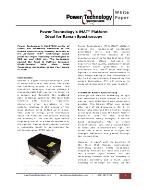

sponsored content

|
Power Technology’s iMAT® Platform Ideal for Raman Spectroscopy
Power Technology’s KLASTECH series of lasers are inherently beneficial to the Raman Spectroscopy industry because of it’s patented iMAT® technology which produces single frequency wavelengths at 532 nm and 1064 nm. This technology earned the Frost & Sullivan European Diode-Pumped Solid State Laser Technology Innovation of the Year award in 2009.
Download White Paper >>
|
|

|
|

CARS Is Finding Its Niche: Overcoming challenges on the path to commercialization
No matter how useful a technology might prove in the research lab, its developers sometimes still have trouble finding a commercial place for it. The technology might be too expensive or too complicated for end users, or the list of applications it serves might simply be too short. So, on the path to commercialization, developers must address a range of issues beyond the question, “Does the technology work?” And, every so often, they must face the possibility that they have gone as far as they can with it. Coherent anti-Stokes Raman spectroscopy has found itself at just such a crossroads.
|
|
|
|

Breast Cancer Laser Technique Faces First Human Trials
A laser diagnostic test, which ultimately could lead to an instant diagnosis of breast cancer at the time of a mammogram, will for the first time be evaluated using excised human breast tissue and lymph nodes. The method, known as spatially offset Raman spectroscopy (SORS), uses a laser to pinpoint objects deep beneath the skin, without an incision.
|
|
|
|


Tiny Probes Dramatically Boost Raman Signals
Novel gold nanoparticles can goose the signal from Raman reporters, or molecules whose jiggling atoms respond to a probe laser by scattering light at characteristic wavelengths. The discovery could lead to better-targeted drug delivery and deeper bioimaging within tissue.
|
|
|
|

Raman Researchers Set a Trap to Cool Ions
Captured ions can be cooled, rather than heated, through contact with cold atoms, and these ion traps can store them in a stable condition for longer periods than previously demonstrated. The results could pave the way to experiments that generate molecular ions at interstellar space temperatures.
|
|
|
|

|

|


Follow Photonics Media on Facebook and Twitter
|
 

|
|

sponsor
 |


|